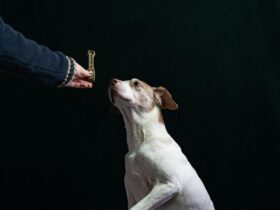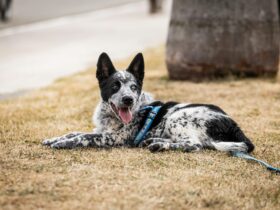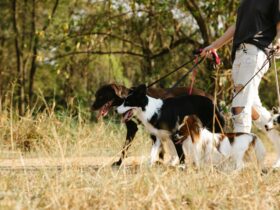Potty training an older dog may seem daunting, but with patience and the right approach, it’s entirely possible. Whether you’ve adopted a senior dog or are dealing with new behavior issues, the principles of potty training remain consistent. This guide will walk you through five essential steps to successfully potty train your older dog, along with tips for overcoming common challenges and establishing a consistent routine.
Step 1: Understand Your Dog’s Needs and Health
1. Evaluate Health Conditions
Before beginning potty training, it’s crucial to ensure there are no underlying health issues that could be contributing to accidents:
- Visit the Veterinarian: Schedule a check-up with your vet to rule out any medical problems such as urinary tract infections, diabetes, or other conditions that could affect your dog’s bathroom habits.
- Assess Mobility: Older dogs may have mobility issues that make it difficult for them to go outside. If this is the case, consider making adjustments to accommodate their needs.
2. Identify Behavioral Factors
- Previous Training: If your older dog has lived in different environments or had inconsistent training, they may need extra time to adjust to a new routine.
- Current Habits: Observe your dog’s current bathroom habits and routines. This will help you identify patterns and determine the best approach for training.
Step 2: Establish a Consistent Routine
1. Set Up a Schedule
- Regular Potty Breaks: Establish a consistent schedule for taking your dog outside. Older dogs may need more frequent breaks, so aim for every 2-4 hours, especially after eating, drinking, or sleeping.
- Bedtime Routine: Ensure that your dog has a final potty break before bedtime to minimize accidents overnight.
2. Create a Designated Potty Area
- Outdoor Potty Spot: Choose a specific area in your yard for your dog to use as their potty spot. This helps them associate the area with bathroom breaks.
- Indoor Options: If your dog is unable to go outside, consider using indoor potty solutions such as pee pads or a designated indoor potty area. Ensure this area is easy for your dog to access and clean.
Step 3: Use Positive Reinforcement
1. Reward Good Behavior
- Immediate Rewards: Praise and reward your dog immediately after they go potty in the right place. Use high-value treats and enthusiastic praise to reinforce the behavior.
- Consistency: Be consistent with rewards to help your dog understand that going potty outside or in the designated area is a desirable behavior.
2. Avoid Negative Reinforcement
- No Punishment: Never punish your dog for accidents. This can create fear and anxiety, making training more challenging. Instead, focus on reinforcing positive behavior.
- Calm Responses: If an accident occurs, clean the area thoroughly with an enzymatic cleaner to eliminate any lingering odors. This will help prevent your dog from being attracted to the same spot.
Step 4: Monitor and Manage the Environment
1. Supervise Your Dog
- Indoor Supervision: Keep a close eye on your dog when they are indoors, especially if they are still learning. Use baby gates or crate training to manage their access to different areas of the house.
- Outdoor Monitoring: Ensure that your dog has sufficient time and opportunity to go potty when outside. Allow them to sniff around and find the right spot.
2. Adjust Living Conditions
- Accessible Potty Area: Make sure the designated potty area is easily accessible for your older dog. This may involve providing ramps or making the area easy to reach.
- Comfortable Environment: Ensure that your dog’s living space is comfortable and conducive to successful potty training. This includes providing a clean and safe environment where they feel secure.
Step 5: Be Patient and Persistent
1. Gradual Adjustments
- Adapt to Changes: Understand that older dogs may take longer to adapt to new routines. Be patient and make gradual adjustments to the training process as needed.
- Encourage Progress: Celebrate small successes and progress in your dog’s training. Positive reinforcement and encouragement can help motivate your dog to continue learning.
2. Consistency is Key
- Stick to the Routine: Consistency in your routine and training methods is crucial for success. Maintain a regular schedule and be consistent with rewards and supervision.
- Adapt as Needed: Be prepared to make adjustments based on your dog’s individual needs and progress. Flexibility and patience will help you achieve the best results.
Troubleshooting Common Challenges
1. Accidents in the House
- Frequent Breaks: If accidents are happening frequently, increase the number of potty breaks and ensure that your dog is getting enough opportunities to go outside or use the indoor potty area.
- Monitor Behavior: Look for signs that your dog needs to go, such as sniffing, circling, or restlessness. This can help you intervene before an accident occurs.
2. Resistance to New Routine
- Gradual Introduction: Introduce changes to your dog’s routine gradually to avoid overwhelming them. Make small adjustments and provide plenty of positive reinforcement.
- Seek Professional Help: If resistance persists or if you encounter significant challenges, consider seeking advice from a professional dog trainer or behaviorist who can provide personalized guidance.
3. Health Issues
- Regular Vet Check-Ups: Regular veterinary check-ups are essential for monitoring your older dog’s health and addressing any issues that may affect their potty training.
- Address Medical Concerns: If health issues are contributing to accidents, work with your vet to address and manage these conditions effectively.
Tips for Success
1. Stay Positive and Encouraging
- Positive Attitude: Approach potty training with a positive attitude and remain encouraging throughout the process. Your dog will respond better to a supportive and understanding approach.
- Celebrate Success: Celebrate your dog’s achievements, no matter how small. Positive reinforcement and encouragement help build confidence and reinforce good behavior.
2. Maintain a Clean and Safe Environment
- Thorough Cleaning: Use enzymatic cleaners to thoroughly clean any accidents. This will help prevent your dog from being attracted to the same spot and support successful training.
- Safe Space: Ensure that your dog’s living environment is safe and comfortable, with easy access to their designated potty area.
3. Be Prepared for Setbacks
- Expect Challenges: Understand that setbacks may occur, and be prepared to address them calmly and patiently. Consistent training and a positive approach will help overcome challenges.
- Adjust Strategies: If needed, adjust your training strategies based on your dog’s progress and individual needs. Flexibility is important for achieving success.
Conclusion
Potty training an older dog requires patience, consistency, and a positive approach. By understanding your dog’s needs, establishing a consistent routine, using positive reinforcement, monitoring their environment, and being patient, you can successfully train your older dog to adopt good potty habits. Remember that every dog is unique, and adapting your approach to fit their individual needs will lead to the best results. With dedication and persistence, you can help your older dog become well-trained and comfortable in their home.
Happy training!











Leave a Reply